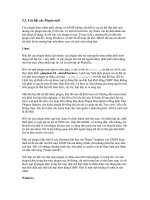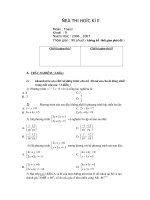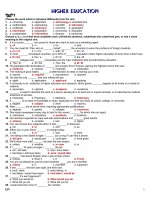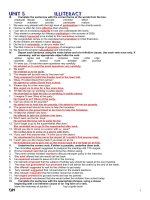- Trang chủ >>
- Mầm non - Tiểu học >>
- Lớp 5
5 3 3 searching for dinosaurs
Bạn đang xem bản rút gọn của tài liệu. Xem và tải ngay bản đầy đủ của tài liệu tại đây (5.39 MB, 14 trang )
Suggested levels for Guided Reading, DRA,™
Lexile,® and Reading Recovery™ are provided
in the Pearson Scott Foresman Leveling Guide.
Life Science
~ by Anne Cambal ~
Genre
Expository
nonfiction
Comprehension
Skills and Strategy
• Fact and Opinion
• Compare and
Contrast
• Predict
Text Features
•
•
•
•
Captions
Sidebars
Map
Glossary
Scott Foresman Reading Street 5.3.3
ISBN 0-328-13539-9
ì<(sk$m)=bdfdje< +^-Ä-U-Ä-U
Reader Response
1. Each of the two paragraphs on page 11 contains
at least one fact and one opinion. Use a graphic
organizer like the one below to write down two facts
byfound
AnneonCambal
and two opinions
page 11.
Facts
Opinions
2. What do you predict the future of animatronics will
be like? On what facts did you base your prediction?
3. Why is the foundation of a thing or a process
important?
4. Which of the photos of the animatronics process did
you find most helpful to you in understanding how
animatronics works? Explain your answer.
Editorial Offices: Glenview, Illinois • Parsippany, New Jersey • New York, New York
Sales Offices: Needham, Massachusetts • Duluth, Georgia • Glenview, Illinois
Coppell, Texas • Ontario, California • Mesa, Arizona
Fascinating Fossils
Why do people like fossils? Fossils are a window into
the past, a look at creatures that lived millions of years
ago. Many of the plants and animals found in fossils are
extinct. We’ll never see them alive. For example, dinosaurs
have been extinct for at least 65 million years. We only
know about them from fossils.
Fossils are the remains of prehistoric plants and
animals that have been preserved in stone. Fossils can be
leaves, seashells, bones, or even footprints or bite marks.
But while fossils are valuable for studying the past, they
can be hard to find.
A scientist uses excavating
tools to carefully remove
fossils from rock.
Every effort has been made to secure permission and provide appropriate credit for
photographic material. The publisher deeply regrets any omission and pledges to
correct errors called to its attention in subsequent editions.
Unless otherwise acknowledged, all photographs are the property of Scott Foresman,
a division of Pearson Education.
Photo locators denoted as follows: Top (T), Center (C), Bottom (B), Left (L), Right (R),
Background (Bkgd)
Opener: Corbis; 1 ©Joan Wiffen; 3 ©DK Images; 5 SuperStock; 6 Photo Researchers,
Inc.; 7 British Library, Getty Images; 8 Corbis; 10 © Project Exploration P.A.S.T; 11 Corbis;
12 Corbis; 13 ©Joan Wiffen; 15 ©Joan Wiffen; 16 ©DK Images; 17 Corbis; 18 Corbis;
19 Corbis; 20 Corbis; 21 Corbis; 22 Corbis
ISBN: 0-328-1353 9-9
Copyright © Pearson Education, Inc.
All Rights Reserved. Printed in the United States of America. This publication is
protected by Copyright, and permission should be obtained from the publisher
prior to any prohibited reproduction, storage in a retrieval system, or transmission
in any form by any means, electronic, mechanical, photocopying, recording, or
likewise. For information regarding permission(s), write to: Permissions Department,
Scott Foresman, 1900 East Lake Avenue, Glenview, Illinois 60025.
2 3 4 5 6 7 8 9 10 V0G1 14 13 12 11 10 09 08 07 06 05
Two of the tools used
to excavate fossils
3
A Dinosaur Named Sue
Fossils are most often found in remote areas where
wind or rain exposes a few bones that hint at what is
buried.The remoteness of some areas can make it hard to
find and retrieve fossils. But curiosity drives fossil hunters
to search wherever fossils are found.
Sue Hendrickson, a self-taught fossil hunter, has
traveled all over the world in search of fossils. She has
found fossilized whales in the desert of Peru and 24million-year-old butterflies trapped in amber (fossilized
tree sap) in the Dominican Republic. But her biggest
discovery was made on a fossil dig in the United States.
In 1990, while searching in the Black Hills of
South Dakota, Hendrickson found the fossil skeleton
of a Tyrannosaurus rex. Named “Sue” in honor of
its discoverer, it is the largest and most complete
Tyrannosaurus rex yet found. Sue is believed to be about
67 million years old. It’s estimated that Sue weighed seven
tons when she was alive, and that her skull weighed six
hundred pounds.
People have been finding fossils for hundreds, maybe
thousands, of years. However, the first time a dinosaur
fossil was scientifically described was about 200 years ago.
4
When was the last time you spent a
day with a dinosaur? If you live in the
Midwest, you can visit Sue at the Field
Museum in Chicago, Illinois.
5
Early Fossil Hunters
Georges Cuvier developed the
first system for classifying animals
based on their anatomy, or body
structure. He was a French scientist
and zoologist who lived from 1769
to 1832. Cuvier also developed the
science of paleontology.
Paleontology is the study
of prehistoric life through the
examination of fossils. It includes
the study of Earth’s layers, which
are called strata. These layers help
preserve fossils and provide clues
Georges Cuvier
to their age.
Most scientists no longer use Cuvier’s system of
paleontology. However, Cuvier’s ideas and studies helped
greatly in making paleontology a respected science.
These bands of
rock layers, or
strata, might
contain fossils.
6
Gideon Mantell, an English
doctor who lived during the
early 1800s, was one of the
world’s first paleontologists. He
became interested in fossils as a
teenager and corresponded with
other early fossil collectors.
They exchanged ideas and some
of the fossils they found.
Sir Richard Owen was
nicknamed “the British Cuvier”
for his work in zoology and
paleontology. He lived from
1804 to 1892. In 1842 Owen
first used the word dinosauria,
from which “dinosaur” comes.
Dinosauria is based on the
Greek words for “terrible” and
“lizard.” Owen used the word to
refer to a group of large, extinct
reptiles.
Today, Mantell and Owen
are known as the first people
to identify and classify dinosaur
fossils. They helped turn
dinosaur paleontology into a
major field of study.
Dr. Gideon Mantell
Sir Richard Owen
7
In the early 1800s, one of the most active fossil hunters
was a young woman named Mary Anning. Anning was
from a poor family, but she had a passion for fossils. She
made many important discoveries, and her fossils were
bought by museums, scientists, and European collectors.
Barnum Brown began his career in 1897 at New
York’s Museum of Natural History. In 1902 he won fame
for discovering the first Tyrannosaurus rex fossil. Brown
worked as a paleontologist for sixty-six years, leading fossil
hunts all over the world.
Brown’s work marks the boundary between early
and modern dinosaur paleontology. His discoveries
greatly advanced the study of dinosaurs, but he lacked
the modern equipment of today’s paleontologists.
Now let’s look at the work of some modern dinosaur
paleontologists.
studying dinosaurs Today
Today the field of dinosaur paleontology is thriving,
thanks to the efforts of scientists worldwide. Modern
communication instantly spreads news of each
new discovery. It also makes it easier for dinosaur
paleontologists to resolve disputes regarding how
dinosaur fossils should be classified. Since the early 1800s,
scientists on several continents have discovered more
than three hundred species of dinosaurs!
Europe
Asia
North America
Barnum Brown
Africa
South America
Australia
Antarctica
Some of the areas where
paleontologists have
discovered dinosaur fossils
8
9
A Team of Fossil Hunters
Paul Sereno is a famous fossil hunter. While in
college at Northern Illinois University, he was granted a
behind-the-scenes tour of New York’s Museum of Natural
History. The museum’s displays of dinosaur fossils
fascinated him. Sereno was so impressed that he decided
to study for a career in dinosaur paleontology.
Sereno worked hard to make his dream a reality.
He studied collections of dinosaur fossils in China and
Mongolia and earned a doctorate, or special degree, in
geology from Columbia University. Sereno also married
Gabrielle Lyon, a fellow paleontologist. Together, they
became a team of great fossil hunters and have made many
important discoveries in the field of dinosaur paleontology.
Paul Sereno
10
Scientists assembling a massive
fossil head of Carcharodontosaurus
In 1995 Sereno and Lyon led a fossil-hunting team
to Africa. The trip’s highlight occurred when Sereno
discovered a fossil skull of a dinosaur species named
Carcharodontosaurus. Based on the skull, the team
estimated that a living Carcharodontosaurus would
have been forty-five feet long! Lyon also discovered a
new dinosaur fossil during the trip. Her find was named
Deltadromeus agilis, or “agile delta runner.”
In 1997 Sereno was leading an expedition in the West
African country of Niger. David Varricchio, a member of
Sereno’s team, spotted a fossil claw sticking out of the
desert sand. It was a great find, but even more lay in store.
Eventually, more than four hundred pieces of dinosaur
fossils were found scattered around the claw!
11
What Varricchio had found was a whole new species
of dinosaur. It was named Suchomimus, which means
“crocodile mimic.” The skull of Suchomimus shows that it
ate fish. Suchomimus was given its name because scientists
believe that it ate like a crocodile.
People around the country were excited by the
discovery of Suchomimus. It was mentioned on the front
page of the Chicago Tribune and in Time magazine.
National Geographic even gave the discovery its own
television special!
Paul Sereno and Gabrielle Lyon are known primarily as
fossil hunters. But they have done more than go digging
around for fossils. In 1998 the couple cofounded Project
Exploration. The organization has two main purposes.
It tries to educate people about the latest discoveries in
dinosaur paleontology. At the same time, it wants to get
children interested in careers in science.
Claw from a Suchomimus
12
Joan Wiffen, the
first person to find
a dinosaur fossil in
New Zealand, digs
at an excavation
site.
Joan Wiffen:
Amazing Fossil Finder
Interest in fossil hunting is worldwide. Joan Wiffen is
just one of many fossil hunters based outside of the United
States. She specializes in fossil hunting in New Zealand.
Wiffen first became interested in dinosaurs when she
read stories about them to her young children. It was an
interest that suited her well. She was already an expert
rock collector, having traveled around New Zealand for
years looking for and identifying minerals and gemstones.
During her rock-collecting trips, Wiffen gained a vast
knowledge of New Zealand’s landscape and geology. She
also developed a scientific mindset and the keen eye of
someone who spends her life hunting for objects buried
in the ground.
13
On one occasion while out rock collecting, Wiffen
bought a fossil of a trilobite, a small extinct marine animal,
at a roadside stand.The trilobite made her even more
interested in extinct animals. From then on Wiffen spent
much of her time hunting for dinosaur fossils.
At first Wiffen had difficulty earning respect as
a serious hunter of dinosaur fossils. The scientific
community ignored her because she lacked a degree in
paleontology. They also doubted that any fossils could
ever be found in New Zealand, an island they thought
was too small to have supported the huge prehistoric
creatures.
Wiffen worked hard to prove the scientists wrong. She
read tirelessly about fossils and dinosaur paleontology,
studying the latest theories and discoveries. Her
breakthrough came in 1974, when she found her first
dinosaur fossil. It was the first ever found in New Zealand!
You have now read about some well-known dinosaur
paleontologists and fossil hunters. Nowadays, some dinosaur
paleontologists are involved in a new technology called
animatronics. Keep reading to find out what animatronics is
all about!
14
Joan Wiffen
showed those
who doubted
that New Zealand
had any dinosaur
fossils that they
were wrong.
15
Modern Views of Dinosaurs:
Animation to Animatronics
Anyone who has watched cartoon shows is familiar
with animated cartoons. Cartoon animation was first
developed as an art form during the early 1900s. It is
similar to regular filmmaking. But while regular filmmakers
film people or the natural world, animators film clay
models, drawings, or computer images.
Computers have given a big boost to animation.They
have also helped people develop animatronics, which
combines animation and electronics. This technology is
used to build robot models. Animatronics artists create
electronic devices that make the body parts of their
models move.
bulary
s Voca
Animatronic
animatronics, n.
uses electronics
A technology that
r
e puppets or othe
to animate or mov
d
odels are designe
figures. Robotic m
ur
sa
times. Dino
to move at certain
gs
n include recordin
animatronics ofte
scientists believe
of the sounds that
ve made.
dinosaurs may ha
animate, v.
em
ake something se
To give life to or m
em to
se
oons, the drawings
rt
ca
In
e.
iv
al
be
to
come to life.
animation, n.
ed
of making animat
The art or process
cartoons.
16
Without computers it would be impossible to do
modern animatronics. But animatronics is very different
from the special effects that are made using computers.
When computer artists create special effects, they use
computer programs to draw images that you see later as
part of a film. In many cases the special effects made by
computers have made it unnecessary to build models.
In contrast, animatronics engineers create actual
models. Animatronic models cost a lot of money and take
many hours to design and build. Paleontologists, painters,
sculptors, movers, technicians, and photographers must
all work together in order to create realistic animatronic
models. The following pages describe in detail how an
animatronic model of a dinosaur actually gets made. Just
turn the page to find out more!
17
An artist uses a computer
to draw a blueprint for a
new model of a dinosaur.
How To make an
animatronic dinosaur
model you
1. Make a drawing of the dinosaur
have in mind.
the drawing
2. Build a miniature model using
as a guide.
the
3. Sculpt a full-sized model using
miniature model as a guide.
model.
4. Make a mold from the full-sized
skin of
Pour the material used to make the
the finished dinosaur into the mold.
t will control
5. Design and make the parts tha
the model’s animatronics.
h the
6. Combine the molded figure wit
product.
animatronics to create the finished
works!
7. Test everything to make sure it
18
1. Make a Drawing
First, an artist draws a sketch of the dinosaur.
The sketch is much smaller than the animatronics
model that will be built from it.The artist may study
fossils of the dinosaur. He or she will pay close
attention to individual parts, such as the hands or
head, but will make sure that all the parts are in
proportion in the finished drawing.
The initial drawing serves as the foundation for
the work that follows. It must be done as accurately
and completely as possible, because all the other
steps are based on it.
2. Build a Miniature Model
The artist then makes a small model, so that
everyone can see how the dinosaur will look from
various angles. The model also helps determine
whether the original drawing of the dinosaur can
actually be transformed into an animatronics model.
19
3. Sculpt a Full-Sized Model
The finished miniature model serves as the basis for the
full-sized model. Sometimes the full-sized model is created
by hand. Other times it is built using a process called CAM,
which stands for Computer-Assisted Manufacturing. Any
marks or flaws in the finished full-sized model must be
tidied up before the final details are carved onto its surface.
4. Make a Mold and Cast the Figure
Once the full-sized model is complete, artists use it to
make a mold for the final product. Since the final model
is usually very large, it is often molded in several smaller
sections. These sections must fit together perfectly for
everything to work. At this step the machinery that
controls the final model is placed inside the mold. This
is done to make sure that the machinery will fit properly
into what will become the final model.
An artist assembles a cast of a dinosaur head.
20
Engineers test the machinery that controls the movements
of a dinosaur model.
5. Make the Parts for the Animatronics
At the same time that the molds are made, the
animatronics machinery that controls the final model’s
movements is designed and built. Four different types
of systems are used to create the internal workings of
the dinosaur. These systems are called the mechanical,
structural, surface, and electronic systems. They work
together to move the dinosaur’s head and jaws. They also
support the weight of the figure each time its body or tail
moves. The systems also make the skin look realistic and
coordinate things so that the dinosaur model moves in a
lifelike way.
21
6. Assemble It All
Once work on the molded figure and its animatronics
is complete, everything is assembled and tested. As each
new part of the dinosaur model’s frame is connected, its
machinery and fit are also tested. By testing each section
while it’s being assembled, problems can be identified and
fixed before it is too late.
7. Test, Test, and Retest
Once the entire dinosaur model has been erected, the
final stage of testing begins. The purpose of these tests is
to make sure that all the systems work, that the dinosaur
figure will hold together, and that the color and texture of
the dinosaur will look good on film or on display. During
testing the dinosaur remains in the workshop, where the
equipment and materials are available for making changes.
After the dinosaur model has passed
the tests, it is moved from its workshop to
a new location, where it either becomes
part of a museum exhibit or is filmed in
a movie or television show. This process
usually requires the use of cranes and trucks.
Obviously, none of the scientists, artists, or
engineers involved in building the model
have ever seen a living dinosaur. But they’ve
done their best to create the best possible
model for the museumgoers or moviegoers
to see, hear, and enjoy!
Workers assembling a full size
model of a Tyrannosaurus rex
22
23
Glossary
erected v. built; set up.
foundation n. base; part
on which other parts rest.
mold n. a hollow shape
into which soft or liquid
material is poured and
that gives its shape to the
hardened material.
Reader Response
proportion n. a proper
relation among parts.
tidied v. to have put in
order; to have made neat.
workshop n. a building or
area where work is done.
1. Each of the two paragraphs on page 11 contains
at least one fact and one opinion. Use a graphic
organizer like the one below to write down two facts
and two opinions found on page 11.
Facts
Opinions
occasion n. particular
time.
2. What do you predict the future of animatronics will
be like? On what facts did you base your prediction?
3. Why is the foundation of a thing or a process
important?
4. Which of the photos of the animatronics process did
you find most helpful to you in understanding how
animatronics works? Explain your answer.
24









